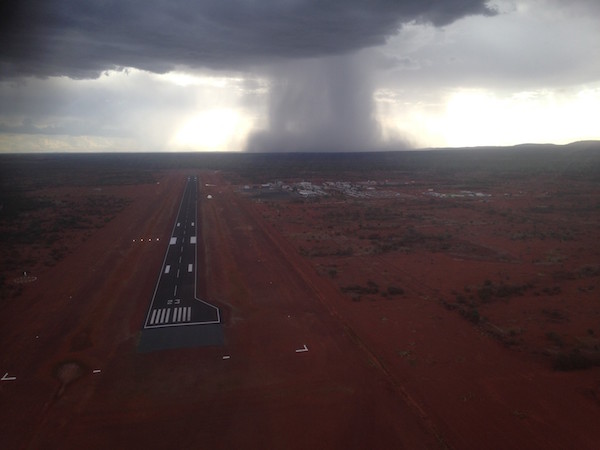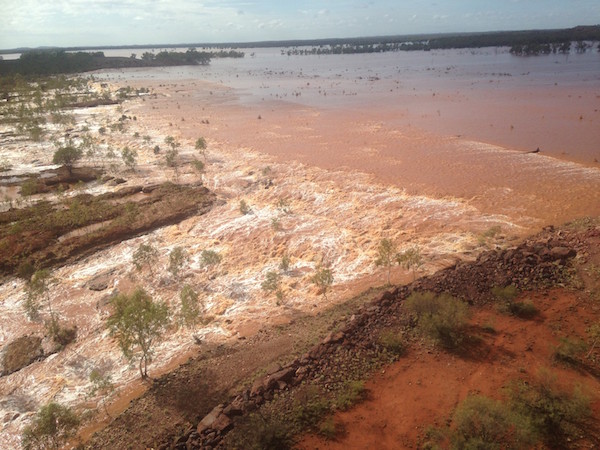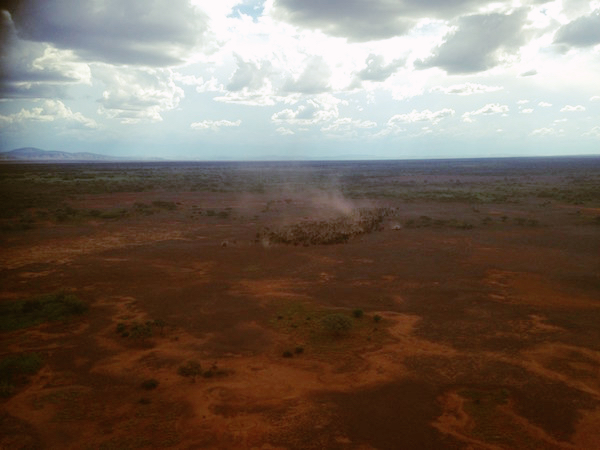So, you want to be a helicopter operator?
Host: Fortescue Helicopters
Written by Weldon Percy – Owner and Chief Pilot, Fortescue Helicopters.
Last year I wrote a post about wanting to be a helicopter pilot. This year, I have now had almost two years of being Chief Pilot and a shareholder of an aerial mustering company; I thought I’d share some of my thoughts about becoming a helicopter operator.
 Newman Airport in the wet season. Photo: Weldon Percy.
Newman Airport in the wet season. Photo: Weldon Percy.
I find it to be a very rewarding feeling to know as a pilot that you have handled a mob of cattle well, had a good muster, flown your helicopter as safe as you possibly can, and have a happy client at the end of the day. It sure makes that XXXX stubby taste even better at the end of the day. It’s been even more rewarding for me to know that it wasn’t just you that had that day, but another six or seven pilots did too, and we’re all working together with you (albeit in different locations) to get the same result. Although I may be the “boss” as such and the buck stops with me, the business would be nothing without having a great team, which at Fortescue Helicopters, I believe we have the best team.
There seems to be quite a misconception that there is a lot of money to be made out of being an aerial mustering company. In my experience, I find it’s much the same as any agricultural or agricultural contracting enterprise. To succeed you have to work bloody hard at it and there’s not a very big margin! This ultimately comes back to the fact that as an industry, agricultural commodity prices have not increased fairly in the past, so producers cannot afford to pay higher rates for our services. That’s a whole other subject and is too much for me to cover here.
 Wildflowers in the Gascoyne region. Photo: Weldon Percy.
Wildflowers in the Gascoyne region. Photo: Weldon Percy.
There certainly aren’t any shiny new Landcruisers, houses, and lengthy vacations to be had in the immediate future. But once again similarly to any agricultural enterprise if you have a long term view, not just a five year one, there will be rewards.
Another common misconception that seems to exist is that there is some fame or stature in the community to be gained from becoming a helicopter company. Also that being “your own operator” means that you can “make your mark”. I don’t believe either of these statements to be true, quite the opposite in fact. I don’t believe that there’s any room for an operator in our industry that thinks they need to be “making their mark” or that thinks they deserve the right to be respected. Rather, I believe we need hard working people who are passionate about safety, of their company’s and pilots, and who strive for better cattle handling and management so as an industry we can support and assist livestock producers and the Australian agriculture industry as a whole.
Simply put, there is no room for heroes and you need to work to earn your respect and not take it for granted.
 Floodwater at the Jimblebar Railway line. Photo: Weldon Percy.
Floodwater at the Jimblebar Railway line. Photo: Weldon Percy.
We have been fortunate to have many very professional operators in our industry to date and I sincerely hope that as new operators come along they take a lead from these individuals and not the ones who have caused us disrepute in the public eye.
 Opthalmia Dam floodway. Photo: Weldon Percy.
Opthalmia Dam floodway. Photo: Weldon Percy.
When considering whether you may go into business as a helicopter operator there a quite a few factors and challenges:
One of the many is finance. Helicopters are considered by most banks and insurance companies as “high risk” and aerial mustering as “very high risk”. The single biggest issue here is that the lady or gentlemen at the bank or insurance broker you are dealing with are generally just normal people who have nine to five corporate jobs. They think that aerial mustering is dangerous because of what they see in the media, and in recent times our industry has had some very poor publicity in terms of how the public view us and what we do (which is a whole other subject again). These people and most of the public including most in general aviation, have no idea of the risk management and decision making that goes into aerial mustering itself, and the management of aerial mustering companies.
This presents a challenge when these people have a preconceived idea of what and who we are. I believe it’s quite important to develop a relationship with your banker and insurer so they understand that you’re not the same person they see on TV doing pirouettes in an R22 chasing one cow, and that you are a professional organisation that provides professional services.
Another financial challenge for a start up from scratch aerial mustering company is that typically there are no written agreements between customers and operators, which in most businesses there are, which also makes financial institutions apprehensive.
Another major challenge is CASA, the Civil Aviation Safety Authority. In my opinion the biggest problem we have with CASA is that they are under-resourced by our government. They do not have the money or the right people to comprehensively implement their own policies or monitor industry compliance. There are a few areas such as training, fatigue management, and maintenance scheduling where CASA could improve their policies to a more best practice and safer risk management approach. But I believe in general that the basic structures we have now whereby operators are bound to have an AOC (Air Operators Certificate), comply, and be held to CASA standards is a good one. Unfortunately due to a few operators not having a fully professional outlook I don’t think self regulation would be a very safe option, as has been recently discussed.
Some pilots and organisations seem to hold a fear or concern that CASA is “after them” or “out to shut is down”. This hasn’t been my experience at all. The CASA people that I’ve worked with have wanted to work together with me to achieve compliance and enhance safety. The biggest problem I’ve had is trying to get them to hurry up and get on with the job. Seemingly simple requests for administrative permits and the smallest of things that would take a normal business a day take CASA 12 months. Once again partly because they are under resourced and also because like the banker and insurer I mentioned earlier most have a poor understanding of what we actually do.
CASA’s current time frames to provide services to industry have become commercially restrictive to industry, especially new operators. It is expected throughout the process of obtaining an AOC that a prospective operator must have a fully functional operating facility (hangar/office/helicopter(s)) for CASA to inspect prior to being approved as an operator. However CASA have taken up to two years in recent times to complete an applicant’s AOC and approve. So in the mean time a prospective applicant would be expected to have come up with the funding to purchase a hangar/helicopter etc but would not legally be able to operate until they receive their AOC, which may take up to two years. Very few people can afford to set themselves up in business and make repayments while they wait for an approval for that long. This is but one example of why CASA need to be resourced better to be able to facilitate these things faster. It doesn’t seem to make a lot of difference whether we have a Liberal/National or Labor government, CASA’s resourcing seems to be getting worse and worse.
An unfortunately seemingly increasingly common occurrence in our industry of late is that of new operators dramatically dropping their price in comparison to others to obtain more or establish themselves work. These people are not only fools to themselves but jeopardise our industry as a whole. As we already operate on very small margins often the only way these people can afford to operate is by cutting corners. This may be in maintenance, compliance, wages, or any other number of areas which ultimately reduce overall safety.
The graziers that use these “cheap” operators, aren’t really helping out the rest of the pastoral industry. They will find that when their “cheap operators” helicopter comes due for major overhaul they can’t afford to continue in business. So then the grazier has to find a new operator/pilot, who most likely doesn’t know their country or cattle and will cost them just as much money in hours learning the property as they saved with the previous “cheap operator”. Alternatively the “cheap operator” continues to fly the aircraft past it’s overhaul limits and ultimately will have an accident. Sadly most accidents are fatal.
The grazier loses a close friend and the industry loses a fellow pilot, and the media runs off with their mouths about how “un-safe” aerial mustering is. In my view graziers as well as aerial mustering companies have a responsibility to uphold and ensure the aerial mustering industry remains safe and prosperous for future generations of graziers.
 Yard up at Mulga Downs. Photo: Weldon Percy.
Yard up at Mulga Downs. Photo: Weldon Percy.
As a matter of personal policy and as company policy at Fortescue Helicopters we strive to be the best, not the cheapest. We strive to handle cattle better, have the best maintained helicopters, have the safest and best trained pilots. This may make us slightly dearer than a competitor but it ensures we prosper as a business and are here for the long term to provide our clients with safe consistent service.
The individuals and operators who partake in trying to undercut and poach work off established operators also very not so coincidentally often seem to be same personality types mentioned above who consider themselves as having a need to be a hero.
Probably the biggest challenge I come across every day is human resource management. From pilots and engineers to bankers and customers some days it feels as though you’re trying to muster 1000 cats to a greyhound track on race day. But this is not unique to aerial mustering and is a challenge for every business alike, so I won’t go into that subject too much.
 Sunrise over Lake Disappointment. Photo: Weldon Percy.
Sunrise over Lake Disappointment. Photo: Weldon Percy.
By now you’re probably thinking, stuff that it’s too hard I don’t want to be aerial mustering operator. But it’s not that bad, the challenges, as some of those mentioned above, are definitely character building at times, but for me I feel it’s all worth it. It’s what I wanted to do for a long time, and being able to work for myself as a mustering pilot with a great team around me makes it the best job in the world in my opinion.
My primary advice for anyone contemplating becoming an aerial mustering company is be respectful. Respect other pilots, respect other aerial mustering companies and their customer relationships. Respect customers. Respect CASA even when they’re driving you mad with waiting times, and respect yourself. Conduct yourself with professionalism no matter who you are dealing with. For you never know where someone might turn up next. Make sure you have thought thoroughly if you truly want to become an aerial mustering company because it takes time to see the rewards (financially). Be patient.
The best avenue to enter the business is by buying an existing enterprise or working in co-operation with another operator. If you’re keen and dedicated to the industry it won’t take long and an opportunity will arise to make a start for yourself.
Well that’s it from Fortescue Helicopters for another season of Central Station.
To Steph, Jane, and the team thanks for the opportunity to contribute to promoting the cattle industry. We hope Central Station can continue it’s great work to date into the future and capture an ever growing audience.
We wish everyone a wet Christmas and prosperous markets for 2016.
